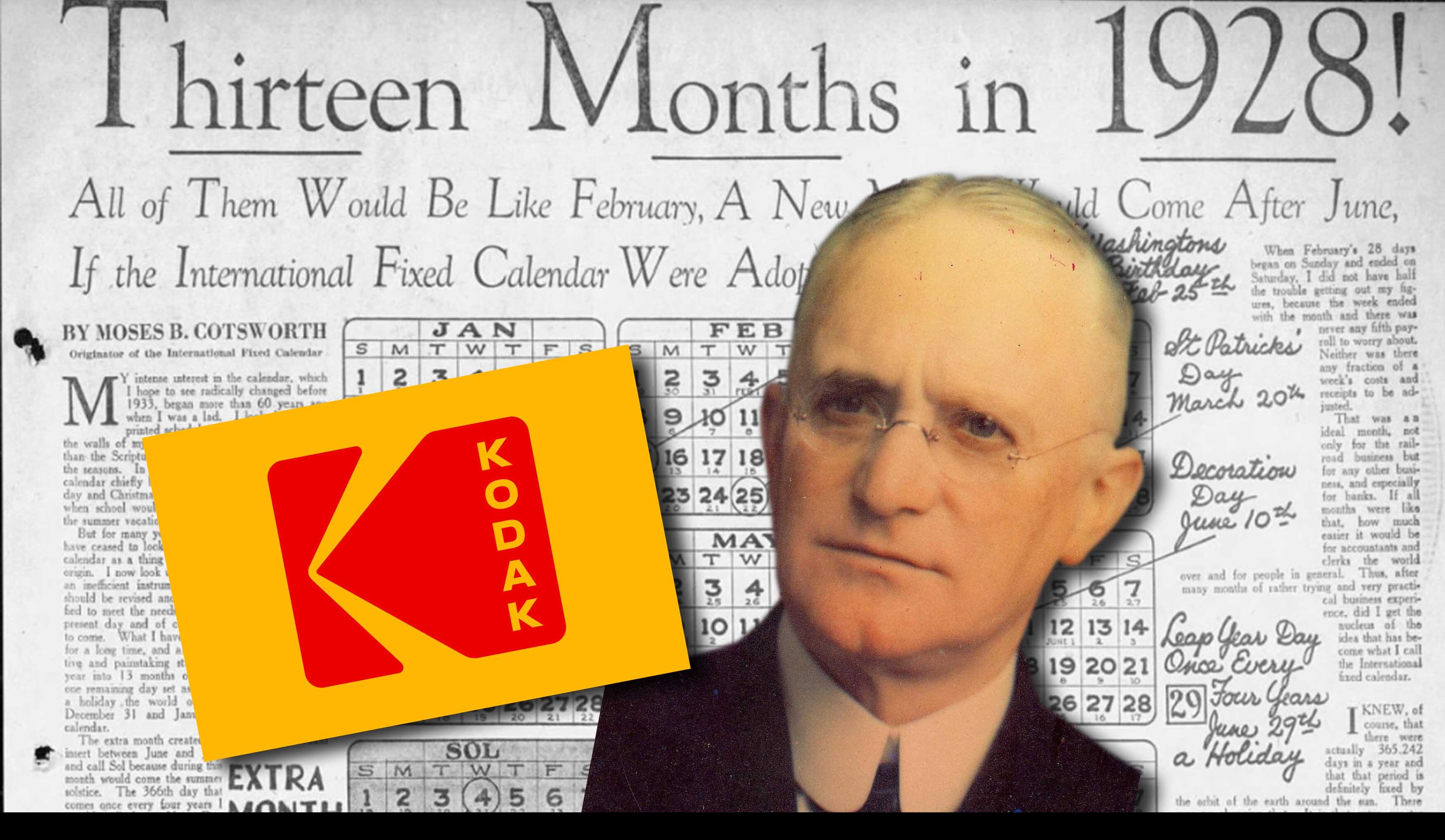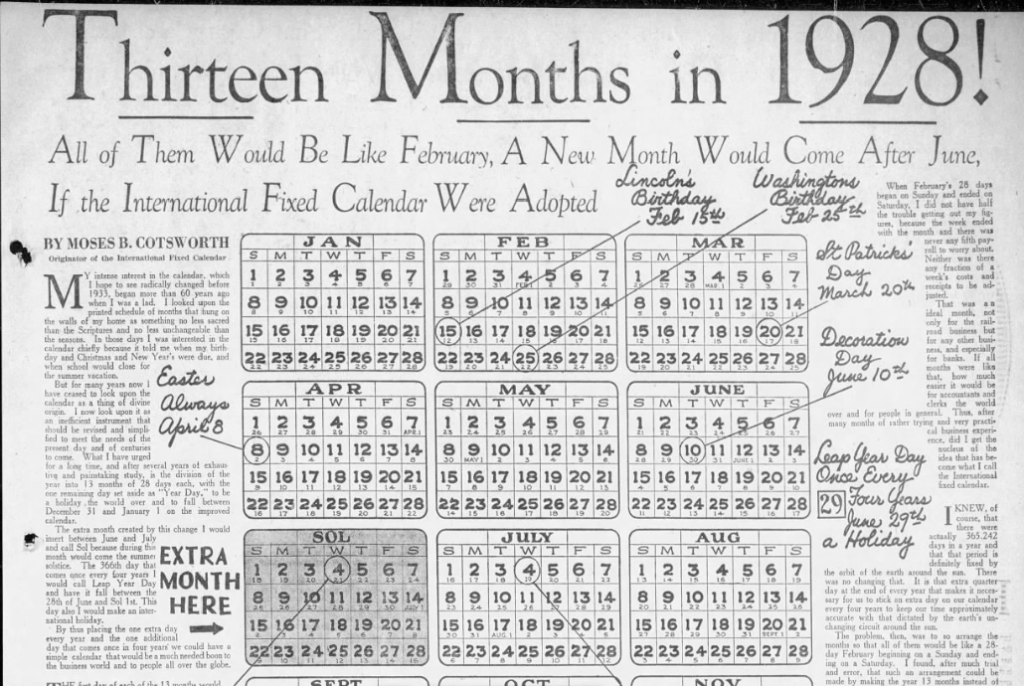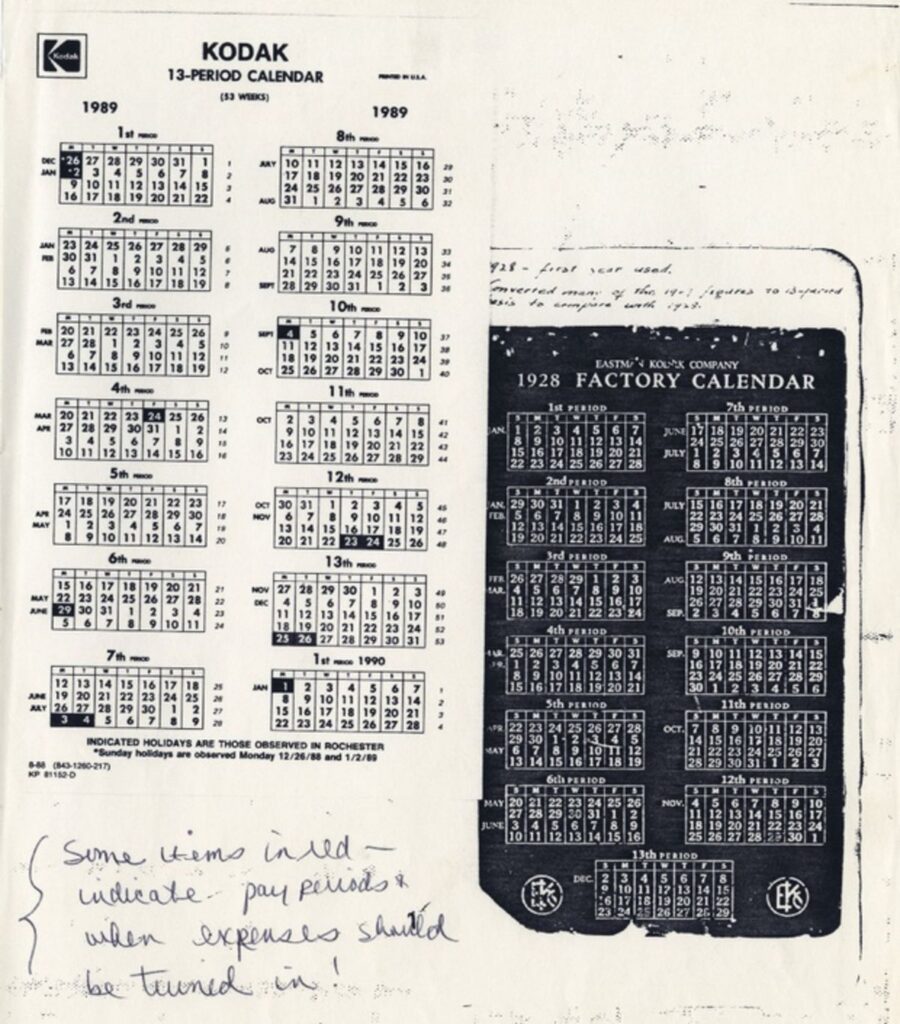13 Months: The Kodak Calendar Experiment
Can you imagine having an extra month between June and July?! In the “International Fixed Calendar,” that’s exactly what was proposed in the 1920s. The only organization to adopt this 28-day-a-month calendar was Kodak, who kept it up all the way until 1989! In this episode, we talk about the Kodak calendar and chat with Comedian Glen Tickle!

Imagine having an extra month between June and July. Sounds pretty great to me! In the International Fixed Calendar, that’s what would happen. 13 months. Extra month of summer. I’m here for it.
Our story begins in the 1920s, but in order to give this idea proper credit, we really have to go all the way back to 1849 and a guy named Augustus Comte.
Comte was a positivist. Positivism is basically a sort of way of looking at everything in the world from a measurable, scientific method. No theology, intuition, or metaphysics – everything must be positively measurable and calculated. And to someone who believes in looking at the world that way, the Gregorian calendar – the one used around the world even today – just feels like chaos. Comte was one of the first people to vocally call for calendar reform.
In Comte’s Positivist Calendar, the year was broken up evenly into 13 months, each consisting of 28 days. For those of you who are awesome at math and just did the calculation in your head, you’re right. That’s only 364 days. Comte had an idea to make that extra day a festival day to commemorate the dead. It wouldn’t have a number, a month or even a day. It wasn’t a Monday or a Friday – it was just the celebration day. As for the months, they would be named after famous figures of history. Moses, Homer, Aristotle, Archimedes, Caesar, Saint Paul, Charlemagne, Dante, Gutenberg, Shakespeare, Descartes, Frederick and Bichat. Super easy to remember right? We’ll just schedule that meeting for the 14th of Archimedes. Well it’s no wonder that the Positivist Calendar didn’t catch on – after all, at this point we had been using the Gregorian calendar for more than 250 years – since 1582. So no one was persuaded.
Quick history on the Gregorian calendar that we use today: It was introduced by Pope Gregory the 13th as an update to the Julian calendar. The Julian calendar came from the Roman calendar and all the Pope Gregory the 13th did was account for leap years by adding in an extra day every few years to keep the year aligned with the astronomical year. The problem was that because of the fact that the solar/astronimical year is slightly larger than 365 days, Easter was falling further and further from the Spring Equinox. So the addition of Leap Year fixed this. We’ve stuck with this Gregorian calendar since 1582 and at this point I can’t imagine changing it. But I’m not George Eastman.
George Eastman founded the Eastman Kodak Company. He brought the idea of the roll of film to the masses and “Kodak Camera” became a household name. The company was started in 1892 and still exists today. It was a leading manufacturer of film, then of cameras, and today they still make chemicals and products to support the print film industry. And from 1928 to 1989 – for 61 years. They operated on their own calendar – the International Fixed Calendar.
Before the break I told you that the Eastman Kodak Company operated on the International Fixed Calendar. So where did George Eastman get the idea?
Well after Augustus Comte invented the Positivist Calendar in 1849 and the idea wasn’t widely adopted, the idea sort of died for 70-some years until a British Accountant named Moses Cotsworth brought it back. In addition to having one of the most British sounding names ever, “Moses Cotsworth, British Accountant,” Cotsworth developed the International Fixed Calendar while working for a railroad company. As you know, railroads rely heavily on timetables and schedules. And the idea that monthly accounts at the railroad couldn’t be evenly and fairly compared with one another really bothered him. Let me give you an example that was laid out in The Outlook, a popular New York periodical in the 1920s:
“A hotel that did a business of $10,000 per week in room sales found that its receipts from room sales were less in May than those in April. It looked as if the business was dropping off. May was one day longer than April and yet its room sales were less. The figures, however, proved to be very misleading. As a matter of fact business was actually better in May than in April – ten dollars a day better – but the monthly comparison seemed to show that it was worse.”
Cotsworth had figured this out and in 1907, formed the International Fixed Calendar League, an organization to gain support for the idea of a fixed calendar internationally. Here’s what his calendar looked like:
The months were the same as the Gregorian calendar currently being used, except every month was shortened to 28 days. An extra month was added between June and July and it would be called “Sol,” S-O-L, named after the sun and because the summer solstice would fall in this month. Now again – if you multiply 28 times 4, you’re still a day short, so a day was added at the end of the year. That day wouldn’t fall within one of the months, or one of the weeks. It wouldn’t have a weekday name – it was simply called “Year Day” and could be a day of celebration. Leap years would still be observed by adding one of these weekless, monthless days between the months of June and Sol.
Here’s what that does. The calendar still lines up with the Gregorian calendar in most respects. Some holidays would have to be moved slightly, but January 1st would still be January 1st. But most importantly, it makes every month the exact same amount of time. Business results could be measured evenly. Every quarter was exactly 91 days and so they were able to be an apples to apples comparison on a ledger. And furthermore, the 28-day month is perfectly divided into 4 even weeks, starting on Sunday the 1st and ending on Saturday the 28th. Every month, the 1st would be a Sunday. The 10th would be a Tuesday and so on. Unfortunately for those who are superstitious, every month would have a Friday the 13th.
You know how you don’t really know what day of the week you were born on without either a) knowing from what your mother told you or b) looking it up on the internet? Well with this calendar you’d instantly know. Because every month, that numbered day would always fall on the exact same day of the week.
In the 1920s, the idea was being spread in publications around the world. Cotsworth placed articles explaining the benefits of the idea in newspapers and magazines. And he made a compelling case, arguing how his new calendar, the International Fixed Calendar, was better for business and better for simplifying the understanding of the dates of the year. He laid out all the reasons, with many newspapers publishing a graphic of what the calendar would look like.
In 1922, a convention was held in Washington to consider the calendar. It was also presented in front of the United States Chamber of Commerce. Cotsworth met with business and labor leaders around the world. And he gained the support of George Eastman of the Eastman Kodak Company. Together, they sent letters to more than 1,000 businesses, trying to persuade them to change to the new calendar.
Even the United State House of Representatives took up the matter when a Minnesota Legislator, Tom Schall, brought it to them in 1919. In their version of the International Calendar, however, the extra month was called “Vern” because of the Vernal Equinox. The idea never made it out of committee. By the way, can you imagine telling people your birthday is Vern 12th?

Unfortunately for the supporters of this radical idea, something like a calendar isn’t easy to change unless EVERYBODY changes. After all, if your business is on the new Fixed Calendar and ships a product to someone on the old Gregorian calendar, how do you tell them when it will get there? It forces you to convert the date any time you communicate with someone else, which then forces you to first find out which calendar they’re using. It’s similar to the headache of asking someone what time zone they’re in before you schedule a meeting.
But there were also religious objections to the calendar. If you’re celebrating a day of rest on the 7th day of the week, whether it be Saturday or Sunday, what do you do with the Free Day? Do you just pretend it didn’t happen? If you don’t, the next year’s day of rest will be off by a day and it will be another 6 years after that before it gets back to the day where it used to be.
These were serious issues for people, and were the reason that almost nobody adopted the calendar. It’s like when video tried to shift from VHS to Laserdisc. It’s cool, but now you have to have both players, because you already own your collection on VHS. Now you have to buy everything again. Compatibility is a serious concern.
Despite no one else adopting the calendar, George Eastman said “I’m doing it anyway,” and in 1928, adopted the International Fixed Calendar for the Eastman Kodak Company. And he continued advocating for the adoption of the calendar – even addressing the League of Nations, who twice took up the idea. In both instances, it was religious leaders who organized to put an end to the idea.
But for Eastman, it was a matter of fiscal tidiness and predictability. In a letter to businessman, Eastman argued, “Nobody is ever sure until he has looked it up whether the first of the month falls in the beginning or the end of the week.”

After the adjustment period, employees actually enjoyed the predictability of the calendar, which was just used internally at the company. Every employee had a pocket-sized calendar with them all the time. Every company boardroom had a large poster of the fixed calendar. And this system worked so well for the company, that they continued to use it for 61 years.
George Eastman’s health started to decline dramatically in 1930. He lived with constant pain in his spine and suffered from horrible depression because of the pain. He took his own life in 1932, but his company lived on – as did their fixed calendar, which they continued to use all the way until 1989.
So the Internet Says it’s True. The Kodak Company operated under their own 13 month calendar for 61 years. And – it could be argued that it’s a better calendar! But if that were a good reason to make a worldwide change, we’d probably be using the Metric system.
Review this podcast at https://podcasts.apple.com/us/podcast/the-internet-says-it-s-true/id1530853589
Bonus episodes and content available at http://Patreon.com/MichaelKent
For a special discount at 1WeekTees, SCOTTeVEST, or FATCO skincare, visit http://theinternetsaysitstrue.com/deals

Sources for this episode:
https://petapixel.com/2012/06/11/kodak-used-a-calendar-that-had-13-months/
https://commonplacefacts.com/2020/02/25/kodaks-13-month-calendar/
https://www.bloomberg.com/news/articles/2014-12-11/the-death-and-life-of-the-13-month-calendar
https://en.wikipedia.org/wiki/International_Fixed_Calendar
https://www.ranker.com/list/strange-history-international-fixed-calendar/stephanroget
https://www.britannica.com/topic/positivism
https://en.wikipedia.org/wiki/Positivism
https://en.wikipedia.org/wiki/Auguste_Comte
https://en.wikipedia.org/wiki/Positivist_calendar
https://www.newspapers.com/image/769046844/?terms=International%20Fixed%20Calendar&match=1
https://en.wikipedia.org/wiki/Gregorian_calendar
https://www.unz.com/print/Outlook-1927sep28-00109
http://www.iisg.nl/collections/matter-of-time/fixed-calendar.php
https://www.bbc.com/worklife/article/20151222-the-case-for-an-entirely-new-calendar

